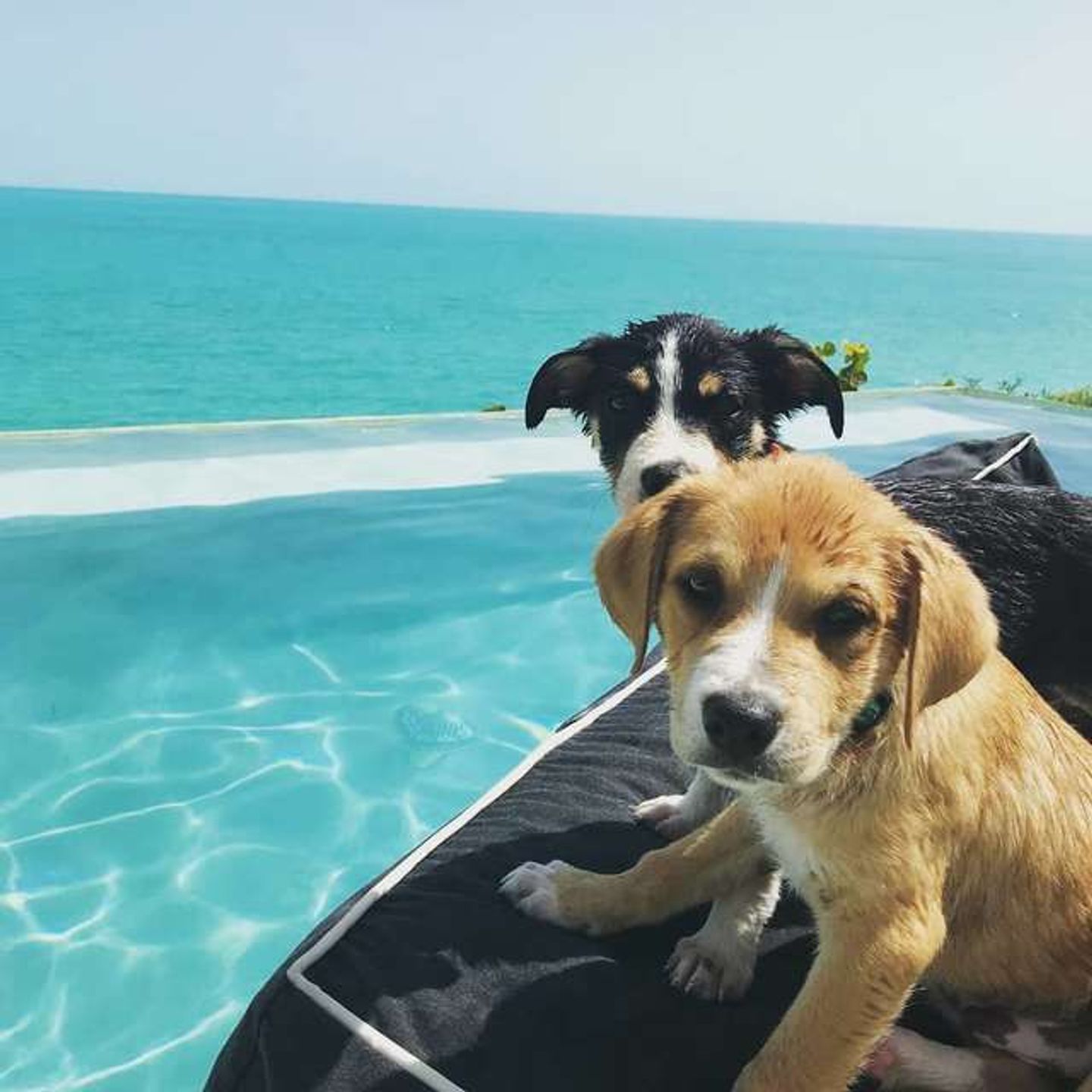
Get wild with cute critters that call the Caribbean home
Mar 22, 2019
Photo: Betty and Royal Brown are the proud parents of four kids born at the Sunset at the Palms resort in Negril, Jamaica , Credit:
By: Melanie Reffes
Source: USA Today
While many book a vacation in the Caribbean for the sun and the sea, exploring beyond the beach is a treat for nature lovers. With an enchanting variety of cute critters calling the islands home, venture beyond the blue and get cuddly with a host of tropical animals from puppies and parrots to goats and monkeys.
Puppy love in Provo

Photo: Potcakes were named for the leftover food caked on the bottom of cooking pots that islanders fed to hungry strays.
A mixed breed that lives in the Turks and Caicos Islands, potcakes were named for the leftover food caked on the bottom of cooking pots that islanders fed to hungry strays. Aiming to curb the number of homeless pups, Potcake Place opened nearly 20 years ago in the Grace Bay area of Providenciales and today is the go-to for tourists looking to adopt a pup or take one to the beach for the day. Smart, loyal and typically smaller than Labrador retrievers, 500 potcake pups are adopted each year by dog lovers like California biology teacher Laurissa Hamilton, who brought Lucie home when she was 10 weeks old. “I noticed her looking at the geese as they flew overhead and paying attention to the wind whipping through the evergreen trees in our neighborhood,” Hamilton explained. “Bringing Lucie home was the best decision I ever made.” Volunteer-run, there is no fee for adopting a dog at Potcake Place although donations are appreciated.
Birds of a feather

Photo: In St. Maarten, Parotte Ville Bird Park is as untouristy as it gets and a delightful option for an afternoon away from the cruise pier and busy beaches.
One of the best-kept secrets in Jamaica, Rocklands Bird Sanctuary is a delightful perch for bird lovers. Located in a rural community called Anchovy, the sanctuary is the only place on the island where a species of hummingbirds called doctor birds flit about in the wild. Visitors are given a vial of sugary water that attracts birds tame enough to land on your finger. Views of the city below are breathtaking and the island’s national birds are friendly enough to pose for photos as they sip the sweet treat.
The sanctuary was once home to Lisa Salmon, who lived there until her passing in 2000. Historians call her the original “bird trainer” who moved to the hills southwest of Montego Bay in the early 1900s. Fond of feeding the birds in the gardens, she noticed they followed her home, where they still flutter about today. Local lore has it that on the day she died, the birds flew away and on the day she was buried, the birds returned. Today, the gardens are as tranquil as they were at the turn of the century and open for visitors under the watchful eye of Lisa’s nephew, Fritz. Admission is $20 and travel time up the mountain from the resorts on the northwest coast is about 20 minutes.
In St. Maarten, Parotte Ville Bird Park is as untouristy as it gets and a delightful option for an afternoon away from the cruise pier and busy beaches. On Bishop Hill Road in the sleepy town of Belvedere, the aviary is a labor of love for its founder, the aptly named George Parotte, who encourages visitors to cavort with birds that whirl overhead with wild abandon. The $10 admission fee includes George’s parrot primer class and seed cups for feeding the people-friendly birds with neon-colored feathers. Under the radar and without a website, the park is available for special occasions. Feeding his feathered friends from a seed cup, Parotte smiled when asked about parties with the parrots. “We haven’t yet hosted a wedding, but we’d be thrilled to arrange one,“ he said. “Our birds are the perfect party guests and happy to act as witnesses should you forget to bring those from home.”
Got your goat

Photo: The new arrivals are the only kids allowed at the adults-only resort.
Upping the cute factor at Jamaica’s Sunset at the Palms, Betty and Royal Brown are the proud parents of four kids born at the resort in Negril. Making her first appearance in the spring of 2017, the affable goat named Betty – a cross between the local goat species and a British breed called Anglo-Nubian – arrived courtesy of a nearby farmer who swapped her for kitchen swaps to feed his pigs. With a big personality, she became the official hostess, popping up in wedding snaps and happy holiday photos. Around the same time, a handsome fella named Royal Brown joined the party and although a shy goat, opposites attract and he and Betty became a couple. To the delight of guests, the resort hosted their wedding which, as it turns out, was a shotgun wedding because Betty delivered her first set of twins soon after. Last year, Betty delivered her second set of twins and like the first set, the new arrivals are the only kids allowed at the adults-only resort. For guests celebrating a special occasion, “Birthdays with Betty” is a guaranteed crowd pleaser.
In Curacao, gaggles of goats roam the island in small herds. Originally brought by the Spaniards, the bearded creatures with tails that point skyward forage for food on the roads leading to the west-side beaches, wander the hillsides around the Santa Barbara Beach & Golf Resort, hang out near the small town of Williwood and take five near Jaanchie”s restaurant. You might also spot a few in Christoffel Park, where nibbling on green shoots is their activity of choice.
Monkey around

Photo: Brought as pets by slaves on the trans-Atlantic journey from West Africa, the clever critters quickly learned how to hunt for food while outwitting their guards.
One of just a few islands with a large population of monkeys, Nevis has been home to vervet monkeys for more than 300 years. Brought as pets by slaves on the trans-Atlantic journey from West Africa, the clever critters quickly learned how to hunt for food while outwitting their guards. Easily noticed with their black faces and cheek pouches stuffed with food, estimates put the total at 30,000 monkeys still living on the island. As social creatures preferring to hang out in groups, they frequent the golf course at Four Seasons Resort Nevis, where they look for food and the tourists who feed them. The monkeys also hang out at the Nisbet Plantation Beach Club.
In Grenada, mona monkeys arrived on ships that sailed from Ghana during the 18th century. Today, you’ll see the white-spotted animals with long tails at the entrance to the Grand Etang National Park and in the mountainous rainforest. Traveling in packs, they emit a warning call that sounds like a sneeze when danger is close by. Not a farmer’s friend, the rambunctious little rascals like to help themselves to crops and to keep hunger at bay, they store bananas and insects in their cheeks.
Flamboyance of flamingos
Photo: On a 40-acre island at the Renaissance Aruba Resort & Casino in Oranjestad, Flamingo Beach is where you’ll find 10 elegant flamingos.
In Anguilla, two flamingos are frequent visitors to Long Pond at the eastern tip of the small British island. Stately with a 5-foot wing span, the birds are not the first flamingos to visit the island yet are welcome arrivals to the wetlands. Flamingo fans can get up close and personal with the birds during tours offered by Nature Explorers Anguilla.
On a 40-acre island at the Renaissance Aruba Resort & Casino in the capital city of Oranjestad, Flamingo Beach is where you’ll find 10 elegant flamingos. No strangers to the island, a flamboyance of flamingos, as a group of the wading birds is called, arrived 15 years ago to make their home on the private island. The gregarious birds that stand up to 5 feet in height still live on the beach happily mingling with visitors. Resort guests have free access with day passes for nonguests available for $125. So as to not to disturb the birds, children are allowed only for one hour between 9 and 10 a.m. Reachable via water taxi from the resort, the island is open from 7 a.m. to 7 p.m.
On Bonaire, Pekelmeer Flamingo Sanctuary is one of only four areas in the world where flamingos breed. From the Dutch word that means “salt lake,” the sanctuary on the southern tip of the Dutch island is home to more than 10,000 flamingos and although tourists are not allowed inside the sanctuary, the birds are visible with binoculars from the road or nearby Pink Beach.



